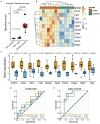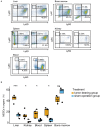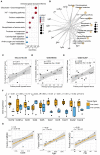Immunosuppressive Microenvironment Revealed by Immune Cell Landscape in Pre-metastatic Liver of Colorectal Cancer
- PMID: 33833986
- PMCID: PMC8021849
- DOI: 10.3389/fonc.2021.620688
Immunosuppressive Microenvironment Revealed by Immune Cell Landscape in Pre-metastatic Liver of Colorectal Cancer
Abstract
Background: Colorectal cancer, the fourth leading cause of cancer mortality, is prone to metastasis, especially to the liver. The pre-metastatic microenvironment comprising various resident stromal cells and immune cells is essential for metastasis. However, how the dynamic evolution of immune components facilitates pre-metastatic niche formation remains unclear. Methods: Utilizing RNA-seq data from our orthotopic colorectal cancer mouse model, we applied single sample gene set enrichment analysis and Cell type Identification By Estimating Relative Subsets Of RNA Transcripts to investigate the tumor microenvironment landscape of pre-metastatic liver, and define the exact role of myeloid-derived suppressor cells (MDSCs) acting in the regulation of infiltrating immune cells and gene pathways activation. Flow cytometry analysis was conducted to quantify the MDSCs levels in human and mice samples. Results: In the current work, based on the high-throughput transcriptome data, we depicted the immune cell infiltration pattern of pre-metastatic liver and highlighted MDSCs as the dominant altered cell type. Notably, flow cytometry analysis showed that high frequencies of MDSCs, was detected in the pre-metastatic liver of orthotopic colorectal cancer tumor-bearing mice, and in the peripheral blood of patients with stage I-III colorectal cancer. MDSCs accumulation in the liver drove immunosuppressive factors secretion and immune checkpoint score upregulation, consequently shaping the pre-metastatic niche with sustained immune suppression. Metabolic reprogramming such as upregulated glycolysis/gluconeogenesis and HIF-1 signaling pathways in the primary tumor was also demonstrated to correlate with MDSCs infiltration in the pre-metastatic liver. Some chemokines were identified as a potential mechanism for MDSCs recruitment. Conclusion: Collectively, our study elucidates the alterations of MDSCs during pre-metastatic niche transformation, and illuminates the latent biological mechanism by which primary tumors impact MDSC aggregation in the targeted liver.
Keywords: MDSC; colorectal cancer; immunosuppressive microenvironment; metabolism; pre-metastatic niche.
Copyright © 2021 Zeng, Wang, Wu, Lin, Ye, Zhou, Wang, Wu, Sun, Bin, Liao, Li, Shi and Liao.
Conflict of interest statement
The authors declare that the research was conducted in the absence of any commercial or financial relationships that could be construed as a potential conflict of interest.
Figures





Similar articles
-
Visualization and quantification of in vivo homing kinetics of myeloid-derived suppressor cells in primary and metastatic cancer.Theranostics. 2019 Aug 12;9(20):5869-5885. doi: 10.7150/thno.33275. eCollection 2019. Theranostics. 2019. PMID: 31534525 Free PMC article.
-
Targeting myeloid-derived suppressor cells in combination with primary mammary tumor resection reduces metastatic growth in the lungs.Breast Cancer Res. 2019 Sep 5;21(1):103. doi: 10.1186/s13058-019-1189-x. Breast Cancer Res. 2019. PMID: 31488209 Free PMC article.
-
Bile acids produced by gut microbiota activate TGR5 to promote colorectal liver metastasis progression by inducing MDSCs infiltration in liver.Int Immunopharmacol. 2025 Jun 17;158:114829. doi: 10.1016/j.intimp.2025.114829. Epub 2025 May 13. Int Immunopharmacol. 2025. PMID: 40367692
-
MDSCs: The Key Players in the Formation of Pre-Metastatic Niche.Front Biosci (Landmark Ed). 2023 Mar 20;28(3):58. doi: 10.31083/j.fbl2803058. Front Biosci (Landmark Ed). 2023. PMID: 37005751 Review.
-
MDSCs: Key Criminals of Tumor Pre-metastatic Niche Formation.Front Immunol. 2019 Feb 7;10:172. doi: 10.3389/fimmu.2019.00172. eCollection 2019. Front Immunol. 2019. PMID: 30792719 Free PMC article. Review.
Cited by
-
Single-cell transcriptomic analysis reveals dynamic changes in the liver microenvironment during colorectal cancer metastatic progression.J Transl Med. 2025 Mar 16;23(1):336. doi: 10.1186/s12967-025-06351-3. J Transl Med. 2025. PMID: 40091048 Free PMC article.
-
Advancements in immunotherapy for colorectal cancer treatment: a comprehensive review of strategies, challenges, and future prospective.Int J Colorectal Dis. 2024 Dec 28;40(1):1. doi: 10.1007/s00384-024-04790-w. Int J Colorectal Dis. 2024. PMID: 39731596 Free PMC article. Review.
-
Myeloid-Derived Suppressor Cells in Cancer: Mechanistic Insights and Targeted Therapeutic Innovations.MedComm (2020). 2025 May 31;6(6):e70231. doi: 10.1002/mco2.70231. eCollection 2025 Jun. MedComm (2020). 2025. PMID: 40452814 Free PMC article. Review.
-
Chemokines in progression, chemoresistance, diagnosis, and prognosis of colorectal cancer.Front Immunol. 2022 Jul 22;13:724139. doi: 10.3389/fimmu.2022.724139. eCollection 2022. Front Immunol. 2022. PMID: 35935996 Free PMC article. Review.
-
Enhancing immuno-oncology investigations through multidimensional decoding of tumor microenvironment with IOBR 2.0.Cell Rep Methods. 2024 Dec 16;4(12):100910. doi: 10.1016/j.crmeth.2024.100910. Epub 2024 Dec 2. Cell Rep Methods. 2024. PMID: 39626665 Free PMC article.
References
LinkOut - more resources
Full Text Sources
Other Literature Sources
Molecular Biology Databases

